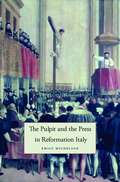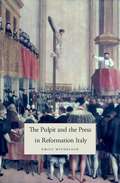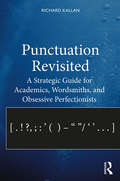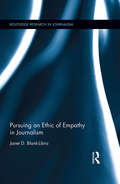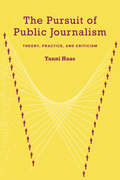- Table View
- List View
Pulling Newspapers Apart: Analysing Print Journalism
by Bob FranklinPulling Newspapers Apart: Analysing Print Journalism explores contemporary UK national and local newspapers at a significant and pivotal moment in their development when some pundits are busily, if mistakenly, announcing their demise. The book offers a detailed examination of features which previous studies have tended to neglect, such as editorial formats (News, Op Ed pages, readers’ letters, cartoons, obituaries, advice columns, features and opinion columns), aspects of newspaper design (page layout, photographs, supplements, online editions, headlines, the emergence of the compact and Berliner editions), newspaper contents (sport, sex and Page 3, royalty, crime, moral panics and politics) as well as the content of newspapers which is not generated by in house journalists (advertising, TV listings, horoscopes, agency copy and public relations materials). This innovative and accessibly written collection provides journalism and media students with an invaluable study of newspapers in the digital age.
Pulling Newspapers Apart: Analysing Print Journalism
by Bob FranklinPulling Newspapers Apart: Analysing Print Journalism explores contemporary UK national and local newspapers at a significant and pivotal moment in their development when some pundits are busily, if mistakenly, announcing their demise. The book offers a detailed examination of features which previous studies have tended to neglect, such as editorial formats (News, Op Ed pages, readers’ letters, cartoons, obituaries, advice columns, features and opinion columns), aspects of newspaper design (page layout, photographs, supplements, online editions, headlines, the emergence of the compact and Berliner editions), newspaper contents (sport, sex and Page 3, royalty, crime, moral panics and politics) as well as the content of newspapers which is not generated by in house journalists (advertising, TV listings, horoscopes, agency copy and public relations materials). This innovative and accessibly written collection provides journalism and media students with an invaluable study of newspapers in the digital age.
Pulp Empire: The Secret History of Comic Book Imperialism
by Paul S. HirschIn the 1940s and ’50s, comic books were some of the most popular—and most unfiltered—entertainment in the United States. Publishers sold hundreds of millions of copies a year of violent, racist, and luridly sexual comics to Americans of all ages, until a 1954 Senate investigation led to a censorship code that nearly destroyed the industry. But this was far from the first time the US government actively involved itself with comics—it was simply the most dramatic manifestation of a long, strange relationship between high-level policy makers and a medium that even artists and writers often dismissed as a creative sewer. In Pulp Empire, Paul S. Hirsch uncovers the gripping untold story of how the US government both attacked and appropriated comic books to help wage World War II and the Cold War, promote official—and clandestine—foreign policy, and deflect global critiques of American racism. As Hirsch details, during World War II—and the concurrent golden age of comic books—government agencies worked directly with comic book publishers to stoke hatred for the Axis powers while simultaneously attempting to dispel racial tensions at home. Later, as the Cold War defense industry ballooned—and as comic book sales reached historic heights—the government again turned to the medium, this time trying to win hearts and minds in the decolonizing world through cartoon propaganda. Hirsch’s groundbreaking research weaves together a wealth of previously classified material, including secret wartime records, official legislative documents, and caches of personal papers. His book explores the uneasy contradiction of how comics were both vital expressions of American freedom and unsettling glimpses into the national id—scourged and repressed on the one hand and deployed as official propaganda on the other. Pulp Empire is a riveting illumination of underexplored chapters in the histories of comic books, foreign policy, and race.
Pulp Empire: The Secret History of Comic Book Imperialism
by Paul S. HirschIn the 1940s and ’50s, comic books were some of the most popular—and most unfiltered—entertainment in the United States. Publishers sold hundreds of millions of copies a year of violent, racist, and luridly sexual comics to Americans of all ages, until a 1954 Senate investigation led to a censorship code that nearly destroyed the industry. But this was far from the first time the US government actively involved itself with comics—it was simply the most dramatic manifestation of a long, strange relationship between high-level policy makers and a medium that even artists and writers often dismissed as a creative sewer. In Pulp Empire, Paul S. Hirsch uncovers the gripping untold story of how the US government both attacked and appropriated comic books to help wage World War II and the Cold War, promote official—and clandestine—foreign policy, and deflect global critiques of American racism. As Hirsch details, during World War II—and the concurrent golden age of comic books—government agencies worked directly with comic book publishers to stoke hatred for the Axis powers while simultaneously attempting to dispel racial tensions at home. Later, as the Cold War defense industry ballooned—and as comic book sales reached historic heights—the government again turned to the medium, this time trying to win hearts and minds in the decolonizing world through cartoon propaganda. Hirsch’s groundbreaking research weaves together a wealth of previously classified material, including secret wartime records, official legislative documents, and caches of personal papers. His book explores the uneasy contradiction of how comics were both vital expressions of American freedom and unsettling glimpses into the national id—scourged and repressed on the one hand and deployed as official propaganda on the other. Pulp Empire is a riveting illumination of underexplored chapters in the histories of comic books, foreign policy, and race.
Pulp Empire: The Secret History of Comic Book Imperialism
by Paul S. HirschWinner of the Popular Culture Association's Ray and Pat Browne Award for Best Book in Popular or American Culture In the 1940s and ’50s, comic books were some of the most popular—and most unfiltered—entertainment in the United States. Publishers sold hundreds of millions of copies a year of violent, racist, and luridly sexual comics to Americans of all ages until a 1954 Senate investigation led to a censorship code that nearly destroyed the industry. But this was far from the first time the US government actively involved itself with comics—it was simply the most dramatic manifestation of a long, strange relationship between high-level policy makers and a medium that even artists and writers often dismissed as a creative sewer. In Pulp Empire, Paul S. Hirsch uncovers the gripping untold story of how the US government both attacked and appropriated comic books to help wage World War II and the Cold War, promote official—and clandestine—foreign policy and deflect global critiques of American racism. As Hirsch details, during World War II—and the concurrent golden age of comic books—government agencies worked directly with comic book publishers to stoke hatred for the Axis powers while simultaneously attempting to dispel racial tensions at home. Later, as the Cold War defense industry ballooned—and as comic book sales reached historic heights—the government again turned to the medium, this time trying to win hearts and minds in the decolonizing world through cartoon propaganda. Hirsch’s groundbreaking research weaves together a wealth of previously classified material, including secret wartime records, official legislative documents, and caches of personal papers. His book explores the uneasy contradiction of how comics were both vital expressions of American freedom and unsettling glimpses into the national id—scourged and repressed on the one hand and deployed as official propaganda on the other. Pulp Empire is a riveting illumination of underexplored chapters in the histories of comic books, foreign policy, and race.
The Pulpit and the Press in Reformation Italy (I Tatti studies in Italian Renaissance history #8)
by Emily MichelsonItalian sermons tell a story of the Reformation that credits preachers with using the pulpit, pen, and printing press to keep Italy Catholic when the region’s violent religious wars made the future uncertain, and with fashioning a post-Reformation Catholicism that would survive the competition and religious choice of their own time and ours.
The Pulpit and the Press in Reformation Italy (I Tatti studies in Italian Renaissance history #8)
by Emily MichelsonItalian sermons tell a story of the Reformation that credits preachers with using the pulpit, pen, and printing press to keep Italy Catholic when the region’s violent religious wars made the future uncertain, and with fashioning a post-Reformation Catholicism that would survive the competition and religious choice of their own time and ours.
Pulsed EM Field Computation in Planar Circuits: The Contour Integral Method
by Martin StumpfThe pulsed EM characterization of planar circuits is of high practical importance in many areas of science and engineering such as electromagnetic compatibility and antenna design. This book is hence devoted to the mathematical formulation and numerical analysis of arbitrarily-shaped parallel-plane structures concerning their pulsed EM propagation, radiation and scattering behavior. The key emphasis is on the time-domain reciprocity-based integral-equation formulations and their efficient numerical solution.
Pulsed EM Field Computation in Planar Circuits: The Contour Integral Method
by Martin StumpfThe pulsed EM characterization of planar circuits is of high practical importance in many areas of science and engineering such as electromagnetic compatibility and antenna design. This book is hence devoted to the mathematical formulation and numerical analysis of arbitrarily-shaped parallel-plane structures concerning their pulsed EM propagation, radiation and scattering behavior. The key emphasis is on the time-domain reciprocity-based integral-equation formulations and their efficient numerical solution.
Pulstechnik: Band 2: Anwendungen und Systeme
by E. Hölzler H. Holzwarthgefallen, dafür wird der Lichtwellenleitertechnik wegen ihrer zukünftigen großen Bedeutung eine ausführlichere Betrachtung gewidmet. Die Be schreibung der dazu notwendigen optischen Bausteine führte zu einer Erweiterung des Abschnitts 5 (Bausteine). Die Berücksichtigung der seit dem Erscheinen der 1. Auflage neu fest gelegten Begriffsbestimmungen und Symbole für logische Verknüpfungen erforderte Korrekturarbeiten größeren Umfangs. Die vollständige Überarbeitung und in wesentlichen Teilen notwen dige Neufassung des Buches haben in dankenswerter Weise wieder die Verfasser der 1. Auflage übernommen; den Unterabschnitt 6.6 über Mikroprozessoren hat freundlicherweise Herr Dipl.-Ing. Karlhorst Barwig, Siemens AG, verfaßt. Wir haben weiteren Experten der Siemens AG zu danken, die uns mit Ratschlägen und Anregungen unterstützt haben, und außerdem Herrn Dr. Kersten dafür, daß er sich neben seinem Buchbeitrag noch den mühevollen redaktionellen Arbeiten unterzogen hat. Dem Springer-Verlag, der wegen der umfangreichen Veränderungen einen vollständigen Neusatz vornehmen mußte, danken wir für die Sorg falt der Ausführung. Möge der Band so gut aufgenommen werden wie sein Vorläufer. München, im Frühjahr 1984 E. Hölzler H. Holzwarth Vorwort zur ersten Auflage Eine Reihe von Gedanken und Feststellungen, die Ziel und Inhalt des zwei bändigen Werkes "Pulstechnik" erläutern, sind im Vorwort zum Band I enthalten. Im Interesse der Leser, die diesen Band nicht besitzen, scheint es zweckmäßig, wesentliche Teile hier erneut wiederzugeben und Inhalt von Band II zu ergänzen.
Punctuation Revisited: A Strategic Guide for Academics, Wordsmiths, and Obsessive Perfectionists
by Richard KallanPunctuation Revisited is an advanced, comprehensive guide to the importance of punctuation in conveying meaning and augmenting the power of a message. Richard Kallan provides guidance on how to structure sentences accurately and in a manner that enhances their readability and rhetorical appeal. This book discusses in fine detail not just when and how to employ specific punctuation marks, but the rationale behind them. It also notes when the major academic style manuals differ in their punctuation advice. These unique features are designed to benefit beginning, intermediate, and advanced students of standard punctuation practice. Punctuation Revisited is a wonderful resource for students of composition and writing, an essential read for writing center tutors and faculty, as well as the perfect addition to anyone’s professional library.
Punctuation Revisited: A Strategic Guide for Academics, Wordsmiths, and Obsessive Perfectionists
by Richard KallanPunctuation Revisited is an advanced, comprehensive guide to the importance of punctuation in conveying meaning and augmenting the power of a message. Richard Kallan provides guidance on how to structure sentences accurately and in a manner that enhances their readability and rhetorical appeal. This book discusses in fine detail not just when and how to employ specific punctuation marks, but the rationale behind them. It also notes when the major academic style manuals differ in their punctuation advice. These unique features are designed to benefit beginning, intermediate, and advanced students of standard punctuation practice. Punctuation Revisited is a wonderful resource for students of composition and writing, an essential read for writing center tutors and faculty, as well as the perfect addition to anyone’s professional library.
Punishing Putin: Inside the Global Economic War to Bring Down Russia
by null Stephanie Baker'The essential, must-read insider account of the West’s cat and mouse economic warfare against Russia and how it is changing the face of global trade. Magisterial and gripping’ Catherine Belton ‘A brilliant, engagingly written and timely book’ Owen Matthews Undeterred by eight years of timid US sanctions, Vladimir Putin ordered his full-scale assault on Ukraine on 24 February 2022. In the hours that followed, Western leaders weaponized economic tools in a world-changing financial experiment. The goal was to sap the strength of Putin’s war machine by damaging its economy, without risking a global recession in the process. In Punishing Putin, veteran journalist Stephanie Baker uncovers how this furious financial war has unfolded, from seizing superyachts to manipulating the global price of oil to blocking the sale of military technology. Baker reveals how the West mobilized an army of white-collar-crime investigators to crack down on illicit Russian money, targeting oligarchs and their enablers for sanctions evasion. Filled with propulsive, fly-on-the-wall details, Punishing Putin takes us into the frantic backroom deliberations that led to a whole new era of economic statecraft and radically rearranged global alliances, influencing world order for generations to come.
'Punto de Vista' and the Argentine Intellectual Left (New Directions in Latino American Cultures)
by Sofía MercaderThis book is the first comprehensive account of the Argentine magazine Punto de Vista (1978–2008), a cultural review that gathered together prominent Argentine intellectuals throughout the last quarter of the twentieth century. Directed by cultural historian and public intellectual Beatriz Sarlo, the story of the magazine serves as a lens to study the evolution of Argentine intellectuals from the leftist mobilization of the 1960s through periods of military dictatorship and then the shifting politics of democratization in the 1980s and 1990s. The book argues that the way in which the Argentine intellectual left negotiated the political and cultural transformations of the late twentieth century can be understood as the history of two political defeats: that of the revolutionary utopias of the 1960s and 1970s and that of the social democrat project in the 1980s. By adopting an interdisciplinary approach, this book encompasses a wide range of debates taking place in Argentina, from the years prior to the dictatorship to the postdictatorship period.
The Purpose of Business: Contemporary Perspectives from Different Walks of Life
by Albert Erisman David GautschiBusiness is a vital institution for a flourishing society, but there is mounting concern about its role in distorting wealth distribution, enabling and rewarding unethical behaviour, and despoiling the natural environment. A Consortium was formed in 2009 under the leadership of David Gautschi to bring together academics, business people, and interested members of society from around the world to discuss two questions: what is the purpose of business, and what is the role of the business school in the academy? Consortium Fellows gathered in eight sessions over five years from 29 countries to discuss, debate, and share perspectives on these questions. The Purpose of Business is an edited collection drawing from the perspectives of these sessions, with contributors from North America, South America, Europe, and Asia bringing culturally and intellectually diverse perspectives on these critical questions. This multifaceted work offers an exploration of business in relation to religion, art, neuroscience, geopolitics, energy, and beyond to inspire a better understanding of the role of business in the 21st century interconnected world.
Purposeful Communication in a Digital Age: Speaking for Success
by Jason Schmitt Arthur KochIn recent years, the process and outlet for public speaking has grown with digital progressions such as TED talks and Facebook Live. Purposeful Communication in a Digital Age, 2nd Edition, provides a practical, step-by-step approach to developing and delivering effective speeches. Offering supplementary articles, case studies, and interviews with key leaders within the text and online, this is an all-in-one resource for the traditional, online, or hybrid classroom. The new edition devotes focus to presenting in the digital world, addressing both traditional and contemporary forms of presentation, and specifically directs students on seeking out credible sources when conducting research. Its eResource features video speech examples, classroom exercises, an instructor manual, and a quiz bank.
Purposeful Communication in a Digital Age: Speaking for Success
by Jason Schmitt Arthur KochIn recent years, the process and outlet for public speaking has grown with digital progressions such as TED talks and Facebook Live. Purposeful Communication in a Digital Age, 2nd Edition, provides a practical, step-by-step approach to developing and delivering effective speeches. Offering supplementary articles, case studies, and interviews with key leaders within the text and online, this is an all-in-one resource for the traditional, online, or hybrid classroom. The new edition devotes focus to presenting in the digital world, addressing both traditional and contemporary forms of presentation, and specifically directs students on seeking out credible sources when conducting research. Its eResource features video speech examples, classroom exercises, an instructor manual, and a quiz bank.
Pursuing an Ethic of Empathy in Journalism (Routledge Research in Journalism)
by Janet Blank-LibraThis book advances a journalistic theory of empathy, challenging long-held notions about how best to do journalism. Because the institution of journalism has typically equated empathy and compassion with bias, it has been slow to give the intelligence of the emotions a legitimate place in the reporting and writing process. Blank-Libra’s work locates the point at which the vast, multidisciplinary research on empathy intersects with the work of the journalist, revealing a reality that has always been so: journalists practice empathy as a way to connect but also as a form of inquiry, as sincere and legitimate in its goals and aspirations as is objectivity.
Pursuing an Ethic of Empathy in Journalism (Routledge Research in Journalism)
by Janet Blank-LibraThis book advances a journalistic theory of empathy, challenging long-held notions about how best to do journalism. Because the institution of journalism has typically equated empathy and compassion with bias, it has been slow to give the intelligence of the emotions a legitimate place in the reporting and writing process. Blank-Libra’s work locates the point at which the vast, multidisciplinary research on empathy intersects with the work of the journalist, revealing a reality that has always been so: journalists practice empathy as a way to connect but also as a form of inquiry, as sincere and legitimate in its goals and aspirations as is objectivity.
The Pursuit of Public Journalism: Theory, Practice and Criticism
by Tanni HaasThe Pursuit of Public Journalism is an engaging introduction to the theoretical foundations and practices of the journalistic reform movement known as 'public journalism.' Public journalism - stated briefly - seeks to reinvest journalism with its fundamental responsibilities to democracy and public life. This book argues against many deeply ingrained practices ranging from journalistic detachment to framing stories via polar conflict in favor of greater civic involvement on the part of journalists. Tanni Haas traces the historical context in which public journalism emerged, develops a philosophy for public journalism, reviews empirical research on public journalism’s performance to date and responds to the major criticisms directed at public journalism. He also examines the particular challenges that public journalism poses to curriculum and instruction: how can journalism educators teach students to write stories useful and of concern to citizens, and how can they encourage citizens to publicly criticize news coverage of given topics? Following review of the major challenges and criticisms of public journalism, the author offers practical solutions for improving public journalism and speculates on public journalism’s likely future.
The Pursuit of Public Journalism: Theory, Practice and Criticism
by Tanni HaasThe Pursuit of Public Journalism is an engaging introduction to the theoretical foundations and practices of the journalistic reform movement known as 'public journalism.' Public journalism - stated briefly - seeks to reinvest journalism with its fundamental responsibilities to democracy and public life. This book argues against many deeply ingrained practices ranging from journalistic detachment to framing stories via polar conflict in favor of greater civic involvement on the part of journalists. Tanni Haas traces the historical context in which public journalism emerged, develops a philosophy for public journalism, reviews empirical research on public journalism’s performance to date and responds to the major criticisms directed at public journalism. He also examines the particular challenges that public journalism poses to curriculum and instruction: how can journalism educators teach students to write stories useful and of concern to citizens, and how can they encourage citizens to publicly criticize news coverage of given topics? Following review of the major challenges and criticisms of public journalism, the author offers practical solutions for improving public journalism and speculates on public journalism’s likely future.
The Pushing-Hands of Translation and its Theory: In memoriam Martha Cheung, 1953-2013 (Routledge Advances in Translation and Interpreting Studies)
by Douglas RobinsonThis book presents an East-West dialogue of leading translation scholars responding to and developing Martha Cheung’s "pushing-hands" method of translation studies. Pushing-hands was an idea Martha began exploring in the last four years of her life, and only had time to publish at article length in 2012. The concept of pushing-hands suggests a promising line of inquiry into the problem of conflict in translation. Pushing-hands opens a new vista for translation scholars to understand and explain how to develop an awareness of non-confrontational, alternative ways to handle translation problems or problems related to translation activities that are likely to give rise to tension and conflict. The book is a timely contribution to celebrate Martha's work and also to move the conversation forward. Despite being somewhat tentative and experimental, it probes into how to enable and develop dynamic interaction between and reciprocal determinism of different hands involved in the process of translation.
The Pushing-Hands of Translation and its Theory: In memoriam Martha Cheung, 1953-2013 (Routledge Advances in Translation and Interpreting Studies)
by Douglas RobinsonThis book presents an East-West dialogue of leading translation scholars responding to and developing Martha Cheung’s "pushing-hands" method of translation studies. Pushing-hands was an idea Martha began exploring in the last four years of her life, and only had time to publish at article length in 2012. The concept of pushing-hands suggests a promising line of inquiry into the problem of conflict in translation. Pushing-hands opens a new vista for translation scholars to understand and explain how to develop an awareness of non-confrontational, alternative ways to handle translation problems or problems related to translation activities that are likely to give rise to tension and conflict. The book is a timely contribution to celebrate Martha's work and also to move the conversation forward. Despite being somewhat tentative and experimental, it probes into how to enable and develop dynamic interaction between and reciprocal determinism of different hands involved in the process of translation.
Putins digitale Front und die Wahrheit dahinter
by Steven BroschartPutins Krieg in der Ukraine wird nicht nur auf dem Schlachtfeld ausgetragen. Gekämpft wird auch an der digitalen Front. Worte und Informationen sind die Munition der modernen, der hybriden Kriegsführung - gegen das gegnerische Militär, aber insbesondere gegen Zivilisten. Es geht um Manipulation und Kontrolle. Um Verwirrung und Ablenkung von dem, was wirklich geschieht. Doch das Internet wird nicht nur zur Propaganda, sondern auch für die Aufklärung und die Logistik genutzt. Und dabei hinterlässt Russland eine Menge Spuren. Analyst Steven Broschart zeigt konkret, welche psychologischen und kommunikativen Mittel an Putins digitaler Frontlinie zum Einsatz kommen.


